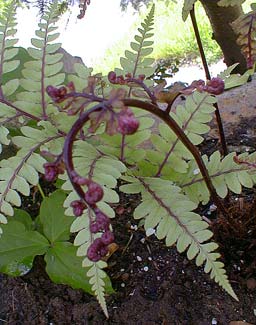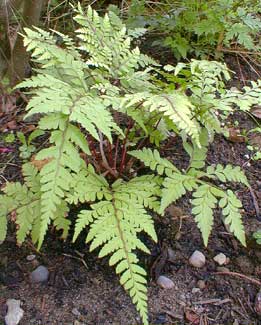
Eared Lady Fern;
aka, Auriculate Lady Fern
"The fragrant fern rejoices by the pond,
And sets your dear face in its feathery frond."
-William Augustus Croffut
1835-1915
1835-1915
The Eared or Auriculate Lady Fern is a common name sometimes misconstrued as "Articulated Lady Fern" & sold under that mistaken variant name. There is nothing articulated about it, but it does have auriculate or ear-shaped crosiers.
Athyrium otophorum var. okanum is a hardy deciduous fern that does well in zones four through nine. It will winter fine to minus 20 degrees F., though young specimens will be tender to establish in zones four through six.
 It is easily sunburned, so wants part to full shade, as well as persistently moist well-draining & humusy soil. In full shade it can bares up quite well to brief bouts of drought, but will stop growing until moisture returns. If never overheated or too dry, it will never require anything else to thrive. It'll grow to a foot or a foot & a half of height, with a spread of one to two feet.
It is easily sunburned, so wants part to full shade, as well as persistently moist well-draining & humusy soil. In full shade it can bares up quite well to brief bouts of drought, but will stop growing until moisture returns. If never overheated or too dry, it will never require anything else to thrive. It'll grow to a foot or a foot & a half of height, with a spread of one to two feet.Ours was originally planted on the dark rear ledge of our jack-in-the-pulpit garden, where the Eared Lady Fern returned rather late each spring, colorful crosiers arising in mid April. The new-leaves & crosier photo at page-top is from the second week in May (2002). A set of trillium leaves have intruded into the picture.
Some nearby Autumn Ferns (Dryopteris erythrosora) overwhelmed & hid the Eared Lady Fern, so in 2004, after having bult up a slope into a flat raised garden, I moved the Eared fern to this new & more central garden spot, shaded by the Oyama magnolia. The second photo from August's end is of the same fern in its new location.
Eared Lady Fern is a close relative to another Asian species, Japanese Painted Fern (Athyrium niponicum var pictum) & like the painted fern has unusual & highly praiseworthy color traits.
The Eared fern's crosiers emerge burgundy & wine-red with shimmering black scales, unfolding into to the most amazingly pale silvery-blue-green fronds, or occasionally yellow- to lime-green fronds, with maroon-purple rachis & stipes (i.e., stems). As can be appreciated in the first photo, the degree of colors manifested in this fern is breathtaking. As the year progresses, the fronds harden & become less colorful, although the stems never cease to be maroon.